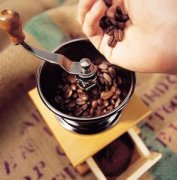Roasting technology of coffee beans
Professional coffee is generally roasted in small batches. The most common baking methods are: tympanic baking and hot air baking.

The drum roaster puts coffee beans in a twist bucket and burns gas or wood to bake them. When the desired baking degree is reached, the coffee beans can be poured into a cooling funnel to prevent overbaking.
Hot air roaster, also known as fluidization air roaster, roasts coffee beans by tossing coffee beans in hot air. Most raw coffee beans are roasted at a temperature of nearly 400 degrees. During the baking process, the volume of coffee beans expands by more than 50%, while their weight decreases.
The color of lightly roasted coffee beans is between cinnamon and light chocolate. Because it tastes sour, it is generally not used to build espresso.
Deep baking, in terms of fighting strength, the flavor of bitterness and sweetness is doubly strong. The fragrance extracted from big coffee beans is proportional to the time of baking.
Baking bet D is poor, the less caffeine, the less acidity. The color of deep-roasted coffee beans is between chocolate or oily brown and black. Baking bet D is poor, the more scorched you taste, the lighter the coffee bean tastes.
Particularly deep-roasted coffee beans will have a smoky taste, it is more suitable for ordinary coffee than Italian coffee.
Many bakers use the following terms to describe different baking degrees: cinnamon, medium baking, city spirit, complete city spirit, dharma spirit and Italian spirit.
A master baker must have the temperament of an artist and the rigor of a scientist. Only in this way can we ensure that the sugar and other carbohydrates in the coffee are carbonized during the baking process, resulting in the well-known coffee fat and producing good coffee of high quality and consistent spirit. Academically, this subtle chemical is not really grease (because it is soluble in water), but it is the source of the aroma of coffee.
On the west coast of the United States, "dharma spirit" is often used to describe the deepest baking. You know, this term has nothing to do with the origin of coffee or the place where it is roasted.
Important Notice :
前街咖啡 FrontStreet Coffee has moved to new addredd:
FrontStreet Coffee Address: 315,Donghua East Road,GuangZhou
Tel:020 38364473
- Prev

Coffee roasting: dehydration, climbing, temperature, smoke extraction and taxiing skills
Search: when is dehydration? How many degrees does it take to climb? Smoke exhaust problem? What is the taxiing action? I would like to give you a little experience. Hand net hot air machine heat engine gas semi-direct fire gas direct fire here is only a brief introduction, please refer to coffee roasting and other related books Ligularia have fun to receive all the negotiations all the way.
- Next

Roasting: an important step in nurturing the fragrance of coffee
Roasted coffee is the most important place to give birth to the fragrance of coffee. In the roasting world, there is no barrier-free passport. Americans like shallow roasting and British people like deep roasting. There is no uniform scale for coffee roasting. Have you prepared raw beans and decided to roast coffee beans with exclusive flavor? If not, you might as well use your imagination and follow me.
Related
- What is the meaning of lactic acid fermentation with coffee bean treatment?
- How to judge the state of foam by sound?
- How does the latte pull out the unicorn pattern? Come to get for a little trick to improve the flower pull!
- Will flower pulling affect the taste of the latte?
- Do you know the history of coffee?
- The difference between honey treatment and sun washing what is raisin honey treatment?
- What kind of milk can a novice use to make coffee foam to keep the foam longer? The correct method and skills of milking tutorial sharing
- Why do washed coffee beans taste sour? Flavor characteristics of washed Coffee
- Introduction to the skill of how to practice the size and height of water injection around the circle of hand-brewed coffee
- How do beginners practice coffee flower drawing from scratch?

